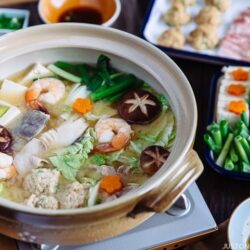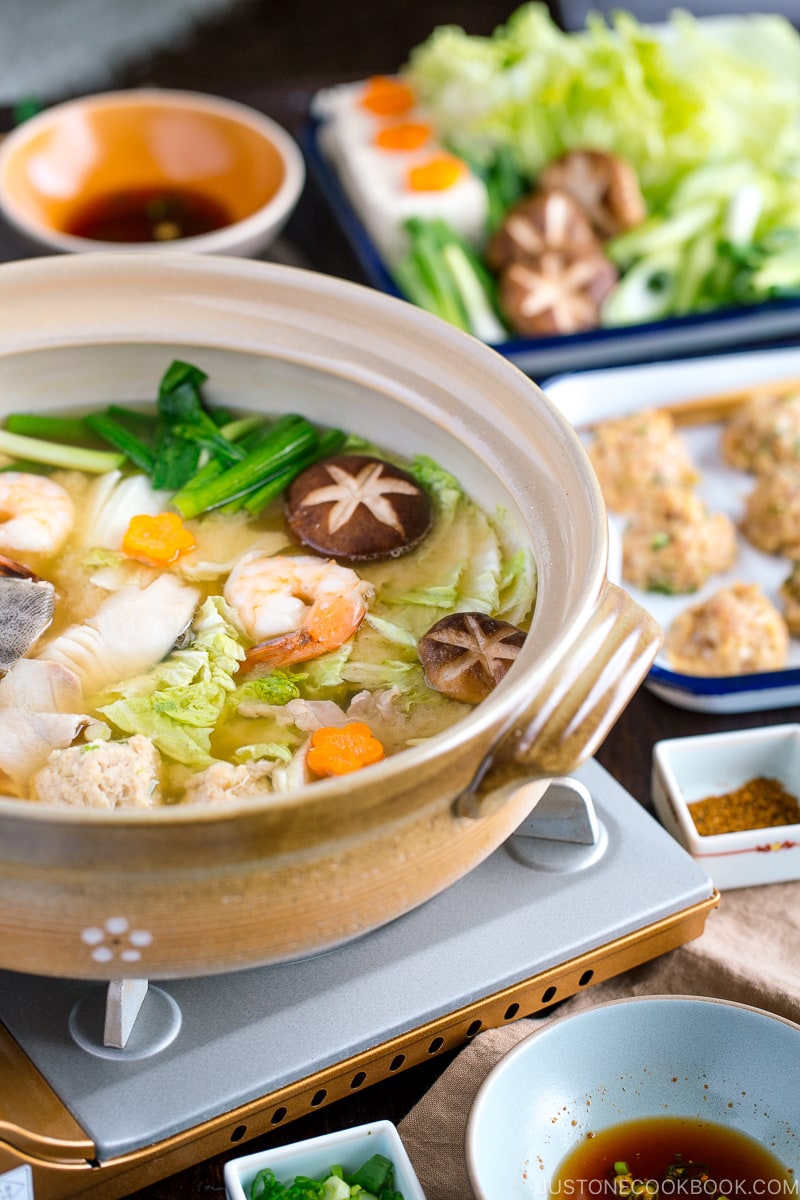
The Japanese enjoy nabe (hot pot) most often in the fall and winter, when the weather is cold. Still, many families enjoy various kinds of nabe dishes throughout the year.
Sumo wrestlers, for example, eat Chanko Nabe (ちゃんこ鍋) year-round—it’s their everyday meal for building strength and stamina!
What is Chanko Nabe?
Chanko Nabe (ちゃんこ鍋) is a type of Japanese nabe (hot pot), which I think is similar to a stew (but with more broth). Sumo wrestlers traditionally eat it in Japan, and it is usually served in massive quantities as part of a weight-gain diet for sumo wrestlers. They eat this meal fairly regularly, using different ingredients.
The characteristic of this hot pot is that there is no specific “recipe”. Unlike other varieties of Japanese hot pot meals, meats, seafood, vegetables, and pretty much everything can be thrown into the hot pot.

The Delicious Broth for Chanko Nabe
The broth for Chanko Nabe is typically made from dashi and/or chicken broth, seasoned with sake and mirin to enhance the flavor.
For good luck before the match, they won’t use beef and pork bones for soup base because four-legged animals represent loss in sumo wrestling (can’t touch the ground with any part of the body other than the soles of the feet). You can use them as ingredients, but not for soup broth.
You can add various flavors to the broth. The most common choices are:
- Miso
- Salt
- Soy sauce
- Kimchi
Today’s recipe is with miso. I recommend using white miso for its mild and creamy flavor.
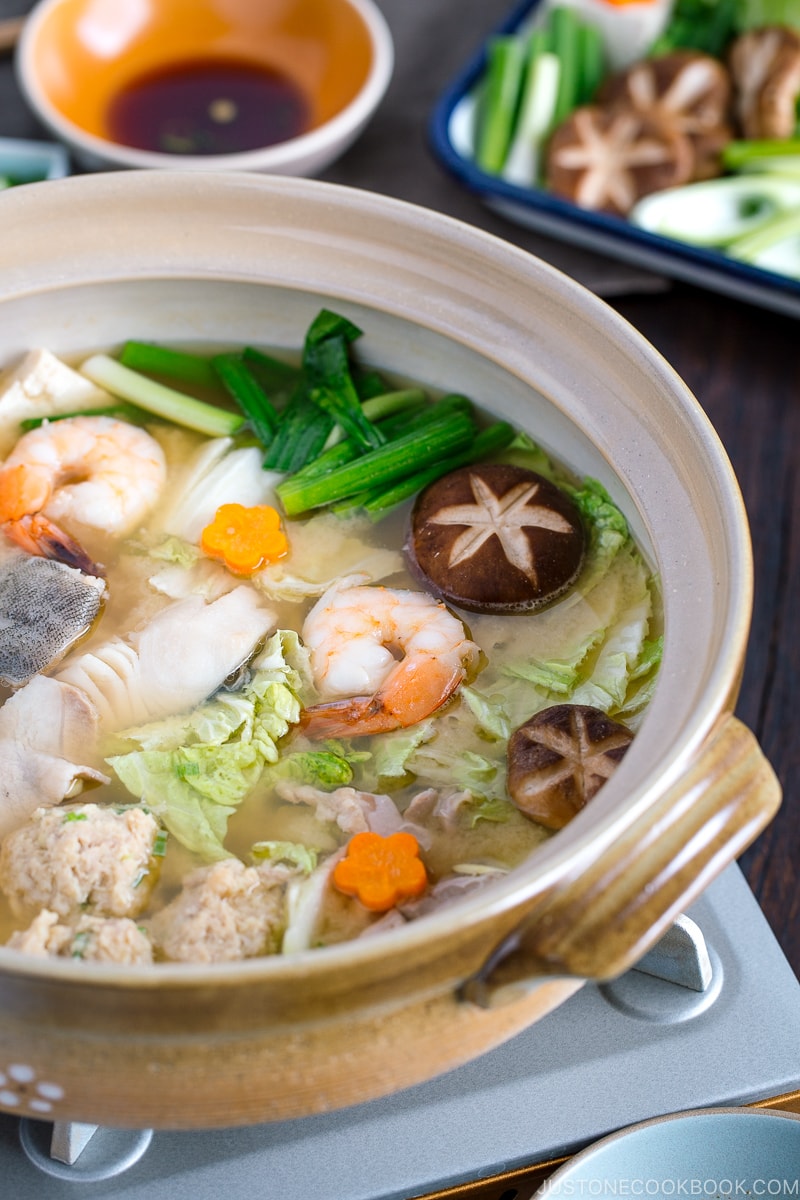
What’s inside Chanko Nabe?
Common ingredients that we throw into Chanko Nabe include:
- Chicken thighs
- Chicken meatballs
- Fish fillet
- Fishballs
- Crab
- Shrimp
- Sliced pork belly
- Bacon
- Sausages
- Tofu (Thick/thin deep-fried tofu, medium-firm tofu, etc)
- Konnyaku
- Garlic
- Kimchi
- Sesame seeds
- Vegetables (daikon, onion, carrot, napa cabbage, green onion, gobo, mizuna, chives)
- Mushrooms (shiitake, enoki, maitake, shimeji, etc)
- Udon noodles or Chuka noodles (Chinese-style noodles)
You can also use leftover Chanko Nabe broth later as the soup for noodle dishes, and I enjoy drinking it as a soup (dilute with water or dashi a little bit if it’s too salty), as it has so much flavor from all the hot pot ingredients.
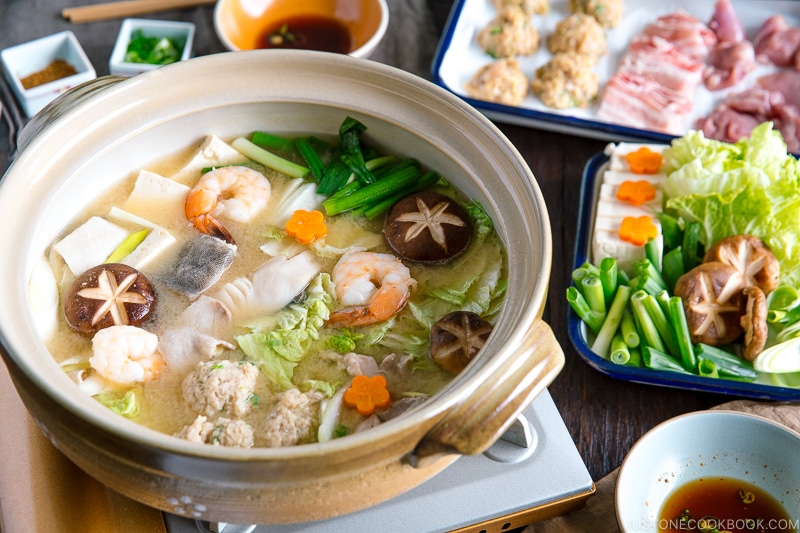
Wish to learn more about Japanese cooking? Sign up for our free newsletter to receive cooking tips & recipe updates! And stay in touch with me on Facebook, Pinterest, YouTube, and Instagram.
Chanko Nabe (Sumo Stew)
Ingredients
For the Broth
- 6 cups chicken stock/broth (for vegan/vegetarian, use vegetable broth or Vegan Dashi)
- ¼ cup sake
- ⅓ cup mirin
- 2 Tbsp ginger juice (grated and squeezed from 4-inch, 10-cm knob; see Step 1)
- 1½ tsp crushed garlic
- ½ cup white miso
For the Chicken Meatballs
- ½ lb ground chicken
- 2 tsp ginger juice (grated and squeezed from 1½-inch, 3.8-cm knob; see Step 1)
- 2 tsp soy sauce
- 1 Tbsp cornstarch
- 6 Tbsp panko (Japanese breadcrumbs)
- 3 Tbsp green onions/scallions (finely chopped)
- ½ large egg (50 g each w/o shell) (beaten)
For the Stew
- chicken meatballs (see instructions; skip for vegan/vegetarian)
- 1½ lb cod fillet (skip for vegan/vegetarian)
- 8 shrimp (skip for vegan/vegetarian)
- 6 oz sliced pork belly (skip for vegan/vegetarian)
- 4 boneless, skinless chicken thighs (skip for vegan/vegetarian)
- 14 oz medium-firm tofu (momen dofu)
- ½ head napa cabbage
- ¼ carrot (for decoration; sliced and cut out with a vegetable cutter)
- 2 Tokyo negi (naga negi; long green onion)
- 6 green onions/scallions
- 4–6 shiitake mushrooms
For Serving
- ponzu (or make my Homemade Ponzu recipe)
- sesame dipping sauce (goma dare)
- 2–3 cups cooked Japanese short-grain rice (or serve precooked udon noodles)
Instructions
To Make the Broth
- Gather all the ingredients for the broth. This 6-inch grater works great for grating ginger and collecting the ginger juice. In this recipe, we use only the juice of the ginger.
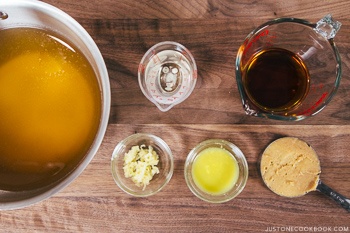
- In a donabe clay pot, Dutch oven, or large pot, combine 6 cups chicken stock/broth, ¼ cup sake, ⅓ cup mirin, 2 Tbsp ginger juice, and 1½ tsp crushed garlic. Bring it all to a simmer over medium heat.
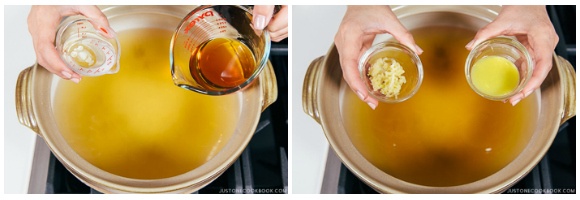
- Once simmering, transfer several spoonfuls of the broth into a measuring cup or small bowl. Then, add ½ cup white miso to the measuring cup and stir until smooth and combined.

- Gradually add the miso mixture back into the broth in the pot, stirring to dissolve any lumps. Once you‘ve incorporated the miso, do not let the broth boil. Turn off the heat as soon as the broth starts to simmer and small bubbles appear around the edges of the pot. Cover and set aside.
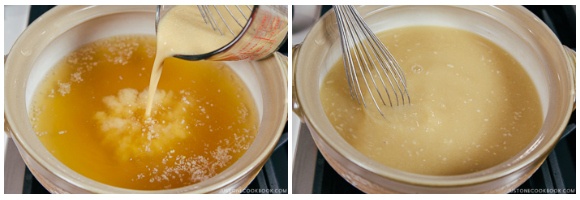
To Make the Chicken Meatballs
- Gather all the meatball ingredients.
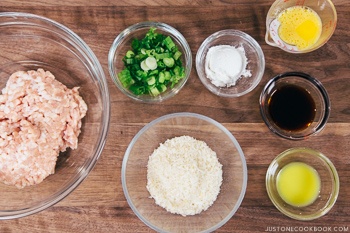
- In a large bowl, combine ½ lb ground chicken, 2 tsp ginger juice, 2 tsp soy sauce, 1 Tbsp cornstarch, 6 Tbsp panko (Japanese breadcrumbs), 3 Tbsp green onions/scallions (finely chopped), and ½ large egg (50 g each w/o shell) (beaten). Using your hands, mix it all together.

- Once the mixture becomes pale and well combined, shape it into 1-inch (2.5-cm) chicken meatballs. If the mixture is too loose to form meatballs, sprinkle in additional panko, as needed.
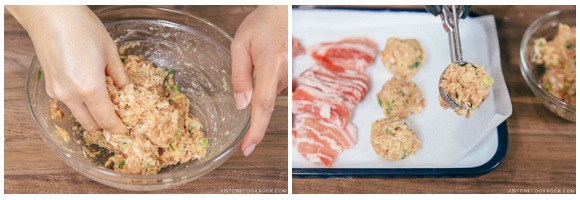
To Prepare the Stew Ingredients
- Cut 1½ lb cod fillet into 2-inch (5-cm) chunks. Peel and devein 8 shrimp. Cut 6 oz sliced pork belly into 2-inch (5-cm) pieces. Trim the visible fat from 4 boneless, skinless chicken thighs and cut the chicken into bite-sized pieces. Cut 14 oz medium-firm tofu (momen dofu) into 1-inch (2.5-cm) cubes. Separate ½ head napa cabbage leaves and cut them into smaller pieces. Finally, slice ¼ carrot and make decorative flower-shaped cutouts (called hanagiri) with a vegetable cutter.
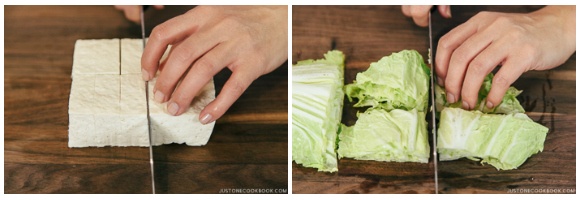
- Cut 2 Tokyo negi (naga negi; long green onion) diagonally into pieces 1 inch (2.5 cm) long and cut 6 green onions/scallions into 2-inch (5-cm) lengths. Remove the stems of 4–6 shiitake mushrooms, making a decorative cut on the caps (called shiitake hanagiri), if desired.
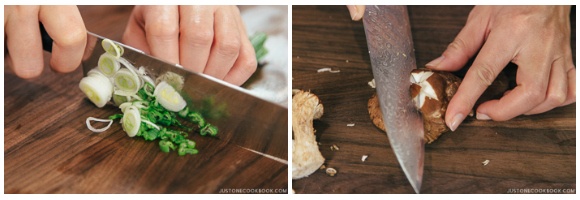
To Set Up the Table
- Place all the stew ingredients—the meatballs, seafood, pork belly, chicken, tofu, carrot slices, napa cabbage, negi, green onions, and mushrooms—on platters. Set the platters on the table.
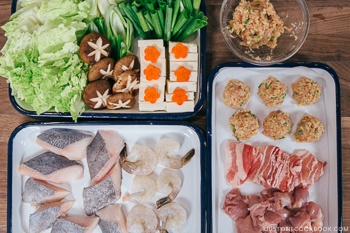
- Pour the ponzu sauce and sesame dipping sauce (goma dare) into individual dipping bowls at each place setting along with chopsticks, a soup spoon (optional), and a soup bowl.
- Set a portable gas burner on the table next to the platters of ingredients. Place the donabe or pot filled with the Chanko Nabe broth on top of the burner. If you don’t have a portable gas stove, you can cook the stew on the stovetop, transfer it to a large bowl, and serve it family style. Or, you can bring the pot to the table and enjoy each batch, then return it to the stove to start a new batch.
To Cook the Chanko Nabe
- Bring the broth to a simmer over medium heat. Once simmering, add the fish, tofu, tough parts of napa cabbage, negi, carrots, and some mushrooms. You don’t have to put all the ingredients in at once; you may cook in batches if you prefer. Cover to cook for 10 minutes, or until the vegetables are tender and the fish is cooked. Transfer the cooked food to individual soup bowls. Then, add the meatballs, meat (or more fish), and vegetables to the broth, and cook covered for 10 minutes. Be aware that the vegetables and tofu cook more quickly than the meatballs, seafood, and chicken.
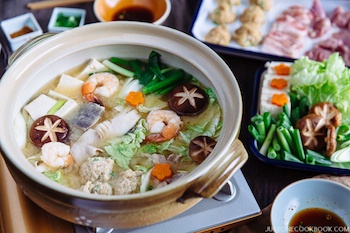
- Keep the broth at a simmer the entire time. If the liquid gets low, add a little water or chicken broth to have enough liquid to heat the noodles or rice at the end. Even though you are thinning the broth, the flavorful ingredients you are cooking will continue to enrich it.
- When diners are ready for the final course, remove any solids in the broth and add 2–3 cups cooked Japanese short-grain rice or precooked udon noodles. Simmer until heated through, then ladle into the soup bowls and serve.
To Store
- You can keep the leftovers in the pot or in an airtight container and store in the refrigerator for 24–36 hours. Reheat to enjoy.
Notes
Nutrition
Did you make this recipe?
Tag @justonecookbook on Instagram so we can see your delicious creation!


